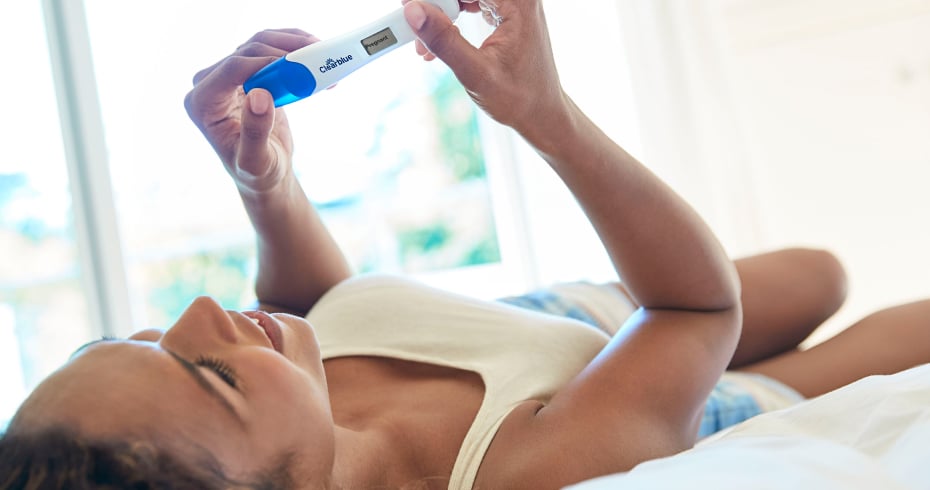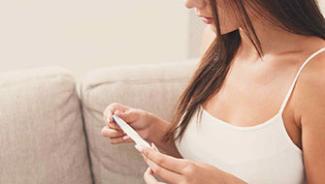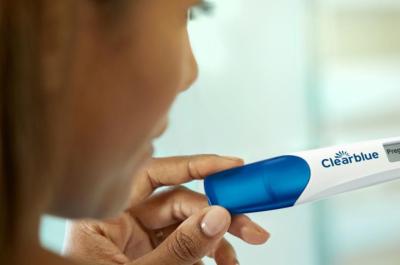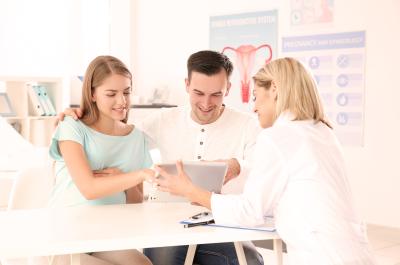
If you think you might be pregnant, you want to know right away. But it’s important to understand what’s happening in your body so you know how soon you can test. Read on to learn all about when to use a pregnancy test, the types of tests available and more!
In this article
- What is a pregnancy test?
- How do pregnancy tests work?
- What are the different types of pregnancy tests?
- How accurate are pregnancy tests?
- When can I take a pregnancy test ?
- Calculate when I can take a pregnancy test
- What are the advantages of using a home pregnancy test?
- Can a digital pregnancy test be wrong?
- What should I do if my pregnancy test is positive?
- Can I be sure my pregnancy test is positive?
- What can cause a false-positive pregnancy test result?
- Do I need to confirm my pregnancy test?
- Which test is right for me?
- How to read a pregnancy test?
- Pregnancy tests at the doctor's office
- FAQs about pregnancy tests
What is a pregnancy test?
Home pregnancy tests (also called HPTs) detect human chorionic gonadotropin (hCG), a hormone produced during pregnancy. When a fertilized egg implants into your uterine wall, the placenta begins to grow, releasing hCG into your bloodstream. Some home pregnancy tests can detect hCG in your urine six days before your missed period. For example, with the Clearblue® Early Detection Pregnancy Test, 71% of pregnancies can be detected 6 days before the missed period (5 days before the expected period).
How do pregnancy tests work?

All home pregnancy tests detect the ‘pregnancy hormone’, human Chorionic Gonadotropin (hCG) in urine. In pregnancy, hCG is produced first by the fertilized egg and later the placenta. A fertilized egg typically implants into the lining of the uterus (womb) as early as 6 days after fertlization, when tiny amounts of hCG start to appear in the mother’s blood and urine. Though hCG levels are very low at first, the level rises rapidly and predictably in the first weeks of pregnancy.1
Even though hCG levels are very low at first, they increase rapidly in the first weeks of pregnancy.
If a pregnancy test detects hCG, your result will be positive and you can be confident that you are pregnant.
If the test is negative, but you tested before the day of your expected period, then there is the possibility you could still be pregnant but your hCG levels were too low for the test to detect. You should test again in a few days’ time, or when your period is due. If you get a negative result on or after the day you expect your period, but still think you might be pregnant, see your doctor.
What are the different types of pregnancy tests?
Urine pregnancy tests
Urine pregnancy tests (also called UPTs) conducted at a doctor’s office work just like home pregnancy tests do: they detect the presence of hCG. The main difference? Unlike a home pregnancy test, you’ll need to make an appointment with your healthcare provider, who will perform and analyze the test. Typically, a nurse will provide you with a plastic cup with a lid. You’ll pee in the cup and then give your sample to the nurse. Just like with a home pregnancy test, you’ll know the result of a urine pregnancy test performed at the doctor’s office fairly quickly as well.
Blood pregnancy tests
Blood pregnancy tests are generally quantitative. If your doctor wants to monitor your hCG levels, they will order a quantitative blood pregnancy test, which measures the amount of hCG in your blood. Most U.S. doctors monitor hCG levels if you have a history of miscarriage or you’re showing symptoms of a possible early pregnancy loss6. Blood pregnancy tests need to be analyzed and the doctor will read the results, so you may not get the results the same day.
How accurate are pregnancy tests?
When it comes to taking a pregnancy test, all Clearblue® tests are over 99% accurate at detecting pregnancy from the day you expect your period4. Some tests can also be used as early as 6 days before your expected period. Just find the right home pregnancy test for you and your needs, and make sure you follow the instructions carefully.
When can I take a pregnancy test?
After the egg is fertilized, it travels to the uterus (womb) and begins to implant in the uterine wall. If implantation is successful, tiny amounts of the pregnancy hormone, hCG, can start to appear in your urine from around 7 – 9 days after ovulation. It is this hormone that all home pregnancy tests detect. Some early pregnancy tests, such as the Clearblue® Early Digital Pregnancy Test and the Clearblue® Early Detection Pregnancy Test, can tell you whether you are pregnant as early as 6 days before your missed period (5 days before you expect your period)2,3.
No matter when you test, you can be confident in the accuracy of a “Pregnant” result with any Clearblue® Pregnancy Test.4
But if you are testing early, before your period is due, you should be aware that even if your result is not pregnant, you may still be pregnant. This is because human Chorionic Gonadotropin (hCG) levels vary from woman to woman, and there may not yet be enough of the hormone for the test to give a positive result.
The day of your expected period is the day your period is due to start. If you still haven’t got your period the next day, this is the first day of your “missed period”. If you see instructions in the leaflet telling you, you can take a test 5 days before expected period, this is the same as 6 days before your missed period. The Clearblue® Early Detection Pregnancy Test, can detect hCG as early as 6 days before your missed period3.
You can use the calculator below to check when you can take a pregnancy test. Most women have menstrual cycles that vary in length from cycle to cycle, which is perfectly normal. If your cycles tend to vary, you should use the longest cycle you’ve had in the last 6 months, in the calculator below.
Calculate when I can take a pregnancy test
* This tool is for guidance purposes. Always use the leaflet provided with your product to work out when you can test.
What are the advantages of using a home pregnancy test?
One of the many perks of home pregnancy tests is convenience. No longer do you need to schedule a doctor’s appointment and wait hours or days for test results to confirm a pregnancy. Most tests allow you to either place the absorbent tip directly in your urine stream or dip the tip in a collected urine sample. Follow the test’s instructions on the insert to ensure you use the test correctly.
Can a digital pregnancy test be wrong?
All Clearblue® Pregnancy Tests are over 99% accurate from the day you expect your period.2 When using any home pregnancy test, there are a few reasons you may get a false positive or false negative result.
A false positive is rare. False positives can occur if you’ve recently had a birth, miscarriage or termination, if you’re taking fertility medications that contain hCG or if you have a rare medical condition. It’s also possible to get a positive result and then experience early pregnancy loss.
You might get a false negative if you don’t have a detectible amount of hCG in your system yet, or if the hCG in your urine is too diluted to detect (which can happen if you drink too much water before testing, for example). Or you may have miscalculated the due date of your next period. False negatives also can occur if you use an expired test or store it improperly.
If you think you’re pregnant and the test is negative, it’s a good idea to wait and test again. If you hadn’t hit your expected period date when you used the test, test again on the day you expect your period. If you’d already reached your expected period date when you used the test, test again three days later. If the results are still negative after testing again but you think you may be pregnant, talk to your doctor.
What should I do if my pregnancy test is positive?
If you get a positive pregnancy test, you are almost certainly pregnant, so it’s best to make an appointment with your doctor or midwife. They can help you discuss your plans and options and ensure you get the care you need.
They may confirm the result with a urine test, or your doctor may do a blood test which can provide more detailed information about the pregnancy, such as the hCG levels.
Your doctor can give you the support you need for a healthy pregnancy, including any advice about any lifestyle changes you may need to make to get the proper prenatal care.
While you are waiting for an appointment, there are a couple of things you can do to support your pregnancy:
- Talk to your healthcare provider about starting to take prenatal vitamins, especially folic acid, if you are not doing so already.
- Start making healthy lifestyle choices, like quitting alcohol and smoking, reducing caffeine consumption, and following a healthy and nourishing diet.
Whether your pregnancy is planned or completely unexpected, your doctor can help support you with the right healthcare you need and can even offer advice or direct you to someone like a midwife or a councillor should you need one. You can also seek advice and care at your local Family Planning Clinic or Sexual Health Clinic.

Can I be sure my pregnancy test is positive?
Yes. Even a faint line on the stick is a positive result and means you are pregnant. Pregnancy tests pick up on the pregnancy hormone hCG (human Chorionic Gonadotrophin), which your body starts making when you get pregnant. Your body will produce more of this hormone during the early stages of pregnancy, and most home pregnancy tests will give you a 99% accurate result if you test from, or after, the day of your expected period. More sensitive tests, like Clearblue Digital Pregnancy Test will detect the presence of hCG from five days before your missed period (which is four days before you expect your period).
Because hCG is usually only present in your body when you’re pregnant, false positive results are incredibly rare. If you use a reliable pregnancy test, like Clearblue, you can be over 99% certain you’re pregnant if you see a positive result.
However, sometimes reading and understanding the result of a pregnancy test can be a little confusing. Since each test is different, make sure you follow the instructions, but most pregnancy tests give you a positive result with the following:
- Two lines. Most tests will have a control line – this just lets you know the test has worked – which shows up as you’re waiting for the results and if you’re not pregnant, you will only see this line. However, if you’re pregnant, you will see two lines. Even if the second line is very faint, this is still a positive result and means you’re pregnant.
- A plus sign. Some tests may show the results with a plus or minus symbol. A negative symbol, means you’re not pregnant; but if you see another line cross the negative line to form a plus sign, this means you’re pregnant. You will also see another line in the control box which tells you the test worked.
Pregnant. You can also get a digital test that literally spells it out for you with the words ‘Pregnant’ or ‘Not Pregnant’, making it easy to understand the results.

What can cause a false-positive pregnancy test result?
Getting a positive result when you’re not pregnant is incredibly rare, and you can read about false-positive pregnancy test results here. The top three reasons you may get a false positive are:
- You’ve recently been pregnant.
- You’ve been taking fertility medications that contain hCG.
- You have a very rare medical condition, like ovarian cysts, that produce hCG and turn your result positive.
Do I need to confirm my pregnancy test?
You don’t have to take another test if you get a positive result, but many women choose to repeat the test just to be sure. If you do get a positive result, book an appointment with your doctor or midwife.
Which test is right for me?
You may feel overwhelmed by the number and types of pregnancy tests on the market. See our guide to Clearblue® tests to find the right test for you:
- Easy, fast testing. If you’ve missed a period and just want to know whether or not you’re pregnant as fast as possible, then why not try the Clearblue® Rapid Detection Pregnancy Test? You’ll see a plus “+” sign for “pregnant” as fast as 1 minute when testing from your missed period or a minus “-” for “not pregnant” in as little as 3 minutes, making the result easy to read.
- Early testing. If you want to know whether you are pregnant but don’t want to wait until you miss your period, you can use our Early Detection Pregnancy Test, which you can use from 6 days before your missed period1
- Digital testing. If, like many women, you want the confidence of an unmistakably clear “Pregnant” or “Not Pregnant” result in words, then our Digital Pregnancy Test with Smart Countdown could be a good option for you.
How to read a pregnancy test?
After taking a pregnancy test, waiting for your result can be an exciting or nerve-racking time, and you want to be confident you are interpreting it correctly. Studies demonstrate that the type of test you choose can make a big difference on how easy they are to read. Tests like Clearblue® Early Digital Pregnancy Test gives you clear results in words. Did you know that nearly 1 in 3 women can misread some types of pregnancy test?5
Pregnancy tests at the doctor's office
The urine pregnancy tests your doctor uses contain the same technology as home pregnancy tests. Doctor’s pregnancy tests also detect hCG just like some home tests, some doctors' tests can be used before you miss your period.
As home pregnancy tests are so reliable, your doctor may not do a second test to confirm a positive test result, though routine practice varies from country to country. If they do a second urine test, often you will have the result in a few minutes. Alternatively, your doctor may do a blood test, either taking a blood sample (blood draw) from your arm, or just a few drops of blood from a finger prick. If a blood sample is taken, it may be sent away to a laboratory, and results will usually take a few days.
FAQs about pregnancy tests
When can I take a pregnancy test?
It depends on the pregnancy test – some even let you test up to 6 days before your missed period.
What are the symptoms of pregnancy in the first week?
As the fertilized egg implants into the uterine lining and the pregnancy hormone hCG (human Chorionic Gonadotrophin) levels begin to rise, you may notice some symptoms. If your cycles are usually regular then the first sign that you’re pregnant is usually a missed period.
However, if your cycles are not regular, you may notice other symptoms first. These can include mild cramping or spotting (known as implantation bleeding). Fatigue and mood swings are also common due to hormonal changes. It's important to note that these symptoms can vary greatly among individuals and some may not experience any early signs of pregnancy at all.
What is the best time of the day to take a pregnancy test?
If you take a pregnancy test after you have missed your period, then you can test at any time of day as your hCG levels will be high enough to be detected by most home pregnancy tests.
However, if you’re testing before you expect your period, when any hCG level would be much lower, you should test with the first urine of the day (when hCG levels are most concentrated) and avoid drinking a lot of liquid (including water) before testing.
Also, make sure to use an “early test” if you are testing before you miss your period.
Can you test too early for pregnancy?
Yes, if you test too long before your period is due, then the levels of hCG in your urine can be too low to be detected by the test, which could lead to a negative result even if you are pregnant.
Should the result be negative, but you still suspect you are pregnant, test again in a few days’ time, or when your period is due.
Why is my pregnancy test negative, but I haven't had my period?
A negative pregnancy test despite a missed period can be perplexing. Several factors can contribute to this scenario.
Firstly, it's possible to receive a negative result if the test is taken too early for hCG levels to be detectable. Many factors such as illness, high levels of stress, significant weight changes, breastfeeding and conditions such as polycystic ovary syndrome (PCOS) can affect how regular your menstrual cycle is, or even make you skip a period.
Additionally, the onset of menopause or perimenopause can cause changes in menstrual cycles. If your period is late and the pregnancy test result is negative, you should take another test in 3 days’ time. For further advice, or if you have any concerns see your doctor.
What are the signs that you should take a pregnancy test?
If you’ve had unprotected sex (especially around your fertile window) and you’ve missed your period, or you’ve noticed other early signs of pregnancy, you may want to take a test.
If you are worried you might be pregnant for any reason, it won’t hurt to take a test.
- Nepomnaschy PA, Weinberg CR, Wilcox AJ, Baird DD. Urinary hCG patterns during the week following implantation. Hum Reprod 2008 Feb;23(2):271–7.
- Clearblue® Early Digital: 78% of pregnant results can be detected 6 days before your missed period.
- Clearblue® Early Detection: 77% of pregnant results can be detected 6 days before your missed period.
- 99% accurate at detecting typical pregnancy hormone levels. Note that hormone levels vary. See insert.
- In a study of 111 women in the UK using and reading different test type. Data on file.
- “What is HCG?” (n.d.), American Pregnancy Association, https://americanpregnancy.org/getting-pregnant/hcg-levels/.

How to use a pregnancy test
When and how you can test depends on the test you use, but in this article you will find everything you need to know before starting a test.




